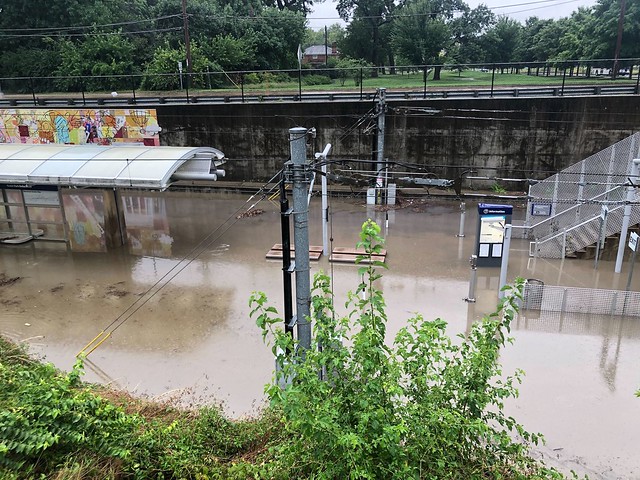MetroLink Flood Damage Update
Return to BlogSome of you have been asking why MetroLink service, especially the Blue Line, is not back to normal yet following last month’s flash flooding. We know you are tired of having to catch bus shuttles so you can transfer between the Blue Line and the Red Line.
Since the historic rainfall (officially 9.04” in 24 hours) our region experienced on July 26, our team has been working around the clock to restore service. Even though MetroLink schedules and operations are not back to normal yet, we wanted to share some behind-the-scenes information about what we have been doing to keep you moving.
The majority of the damage is concentrated on a two-mile stretch of the MetroLink system from the Forest Park-DeBaliviere Station to the Delmar Loop Station. Damage is estimated to be in the millions of dollars.
- One MetroLink train stranded in flood waters at the Delmar Loop Station is a total loss
- Both station elevators at the Forest Park-DeBaliviere Station must be replaced
- MetroLink communications and fiber optics sustained substantial damage
- MetroLink signal systems housed in two communication rooms and four signal houses all sustained substantial damage
- DeBaliviere MetroLink signal house is also a total loss after taking on nearly seven feet of water
- About five miles of light rail track bed was damaged
Our crews were able to make track bed repairs in the first 72 hours, so we could cancel the Red Line bus shuttles and reopen train service on the Red Line. After other repairs were completed, we were able to resume Red Line service from St. Louis Lambert International Airport to the Shiloh-Scott Station.
We are still experiencing delays because we cannot operate trains at normal speeds through the flood-damaged area due to the significant damage to the signal houses and communications equipment.

Because the Red Line and Blue Line meet at the Forest Park-DeBaliviere Station, the DeBaliviere signal house plays a critical role in maintaining safe operations at that intersection. Since the DeBaliviere signal house is a total loss and the signal and communications systems still down, we are currently unable to move the Blue Line and Red Line trains through the Forest Park-DeBaliviere Station. That is why you have to catch a MetroLink Station Shuttle to transfer between the two lines. We are devoting a lot of time and attention to clean and assess each piece of those highly sensitive and intricate electrical systems that was underwater to see what can be repaired and what components must be replaced with new equipment. It will be several months before we can fully restore MetroLink service on the Red and Blue Lines in the City of St. Louis City and in St. Louis County.
In the meantime, our main goal is to make it easier as soon as possible for you to transfer between the Blue Line and Red Line by train again at the Forest Park-DeBaliviere Station. We are working on a plan that will provide you that option in the coming days so please stay tuned. Thank you for your patience and understanding as we navigate this unprecedented challenge.
For the latest information on service, visit our Special MetroLink Operations page. For questions or assistance with planning your Metro commute, please contact Metro Transit Information, available Monday through Friday from 7 a.m. to 6 p.m. at 314.231.2345 (phone) or 314.207.9786 (text).



Thank you for this update! It’s very helpful to know the situation and now we can plan our commutes for the next few months. I know everyone is working hard to restore service and I appreciate our awesome light rail even more now. “You never miss the water till the well runs dry,” no pun intended.
What is Metrolink doing to make sure the signaling infrastructure is not destroyed in the next flood?
In addition to repairs, the team will be looking at different ways to protect the system from future flooding – including historic, unprecedented flooding that we experienced in July. One option being considered is elevating infrastructure that houses signal systems and communications equipment to better protect it.